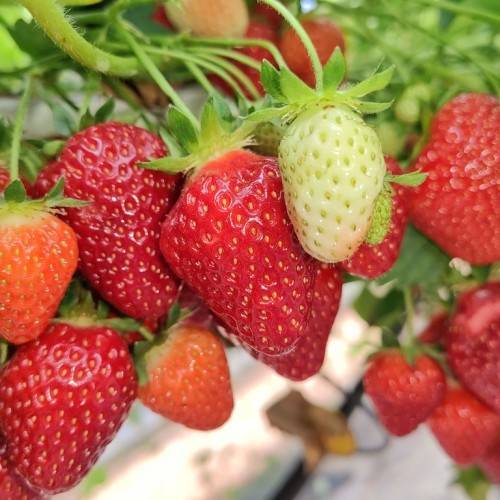
strawberry
Fragaria 'Allstar'
Cycle:
Perennial
Watering:
Average
Hardiness Zone:
4 - 8
Flowers:
Flowers In Spring
Sun:
Full sun
Fruits:
Fruits Ready In Summer
Edible:
Yes
Leaf:
Yes
Growth Rate:
High
Maintenance:
High
Salt Tolerant:
Yes
Care Level:
Medium
watering
Strawberry plants will need to be watered every 5-7 days; however, water more frequently during periods of high temperatures or dry weather to ensure an adequate supply of moisture. Keep the soil moist but not soggy; it should dry to about 1 inch in depth before you water again. Additionally, the soil should be watered until it begins to drain from the bottom of the container. Too much or not enough water can be harmful to the plant's health.
sunlight
Strawberries should receive about 8-12 hours of sunlight per day. When getting the correct amount of sunlight, the plants should get direct sunlight in the morning and late afternoon. Avoiding direct midday sunlight is crucial to the health of the plant. In regions where days are shorter, artificial light, such as fluorescent lighting, can be used to supplement the natural sunlight.
pruning
Strawberry plants, such as the Fragaria 'Allstar' cultivar, should be pruned annually in late winter or early spring when temperatures are warmer but there is still a threat of frost. Start by removing any damaged or old leaves and stems, then focus on the new growth that emerged the previous season. Cut these stems off at the point where they meet the crown of the plant. When pruning strawberry plants, you want to keep the plant at a manageable height of around 8-10 inches (20-25 cm) while maintaining an even shape that allows plenty of access to light and air.
FAQ
How long does it take for strawberry plants to produce fruit?
Strawberry plants typically take 3-4 weeks from flowering to the production of a ripe berry. The entire process of planting and producing fruit can take up to 3 months, depending on the variety of strawberry being grown, climate and growing conditions. Some strawberries may bear fruit as early as 2 months from planting. Minature varieties are often the fastest ripening varieties, while larger varieties may take longer to bear fruit.
Is it possible to grow strawberries from seed?
Yes, it is possible to grow strawberries from seed. Growing strawberries from seed is often considered to be a bit more challenging than other fruits and vegetables, but with the right preparation and patience it can be done. You will need to use fresh, ripe strawberries to get the best chance for successful germination. You will also need to prepare a moist soil mix, plant the seeds in it, and ensure that the environment is moist but not soggy to create ideal germination conditions. If done properly, you can have strawberries ready for harvesting in approximately four months.
Do strawberry plants have shallow or deep roots?
Strawberry plants have shallow fibrous roots that typically grow close to the soil surface, with a spread of 8 - 10 inches. Although they do not have a long, deep root system like some other plants, they do possess an extensive root system that helps to capture moisture and nutrients. The shallow rooting system is beneficial when it comes to protecting strawberry plants from frost and drought.
Is a strawberry a perennial or an annual plant?
A strawberry is an annual plant, meaning that it completes its life cycle, from germination to death, within one growing season. After flowering, each strawberry plant produces one to two quarts of strawberries for the season. The plants then die off and must be replaced in order to continue bearing fruit.
Is it possible to grow strawberries from cuttings?
Yes, it is possible to grow strawberries from cuttings. Take strawberry cuttings from plants that produce large, flavorful strawberries and take cuttings from plants that have been healthy and pest-free. Next, you need to select the healthiest, most vital looking stems from the parent plant and cut them at an angle with sterile scissors or a knife. Plant the cuttings in fertile soil, water them, and then place them in a sunny location. With warm temperatures and proper care, the strawberry cuttings should begin to sprout and form a strong, healthy plant.
Is a strawberry a cool-season or warm-season plant?
A strawberry is a cool-season plant. It prefers growing in the early spring and late fall when temperatures are mild and temperatures don't get too high or too low. It is more sensitive to extreme conditions than many other fruits, so it requires more protection from seasonal fluctuations. When planted in spring, strawberries will bear fruit in summer, and if planted in late fall, they will bear fruit in late spring.
Is the strawberry plants perennial or annual?
Strawberry plants are considered to be perennial plants. This means that they are capable of living for more than two years and generally produce fruit multiple times throughout their lifetime. The plants will come back each year, but the individual fruits need to be replaced annually. This is done by strawberry runners that can be planted in the same spot, guaranteeing the continuity of the strawberry crop.
Are strawberry plants self-pollinating?
Strawberry plants are capable of self-pollination, meaning they possess the ability to fertilize their own ovaries with their own pollen. Self-pollination can happen through a process called geitonogamy, which is when a flower's own pollen grain fertilizes another flower on the same plant. However, strawberry plants still benefit from cross-pollination, which is when pollen is transferred to the female part of the flower from a different plant. This improves the genetic diversity of the plant and increases the yield of fruit.
